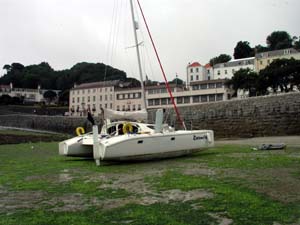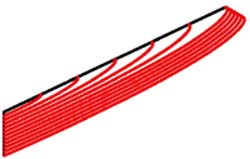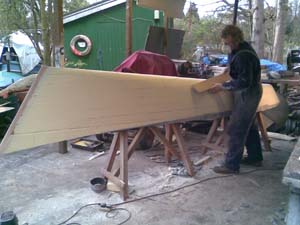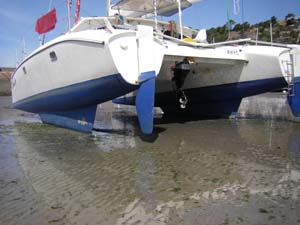

|
| Razzmatazz with original daggerboards |
The aim was to make the boat more directionally stable and free from rattles, while accepting a loss of performance. Also, we wanted to be able to dry out on pebbley beaches without concern. We minded less about overall slowing down than being less weatherly.
Obviously the keels needed to leave the CLR (Centre of Lateral Resistance, ie point you'd have to tow from if you wanted to tow sideways) where it was before, and to support the boat they needed to span a good distance fore and aft of the CG (Centre of Gravity - point you'd need to lift at if you wanted it to stay level).
We took our first, rough sketches to Darren Newton, the designer of the boat, and he gave us a generous slice of his time and invaluable advice based on experience. At the end of this discussion, it was clear that we needed NACA-section foil keels, made from closed-cell foam with a central ply sheet and glassed over. The keels should be glued and glassed to the bottom of the hulls, without any attempt to add stiffening members through or inside the hull. ("Don't mess with the hulls", Darren said.)
There was a difficulty in making the CLR stay where it was before. Darren suggested simply making the centroid (centre, roughly speaking) of the new keels be where the centroid of the daggerboards had been. However, my design textbook stated that the CLR of a foil is at 25% of the distance from the leading edge. So, just working on the centroid while drastically reducing the aspect ratio of the keels would bring the CLR forward, and possibly ruin the handling of the boat.
I was sceptical whether the 25% rule applied to LAR keels, but didn't know how to proceed without building scale models. Anyway, I posted the problem on the multihulls@steamradio.com forum, where I knew clever and knowledgeable people where to be found. The response was that a 35% rule was closer to reality with LAR keels, and that the exact position of the CLR was not too critical on a fast cat.
When I did some initial drawings, I found the keel had then to be inconveniently aft to position the CLR correctly. I solved the this problem by making the keel deeper at the back than the front. Luckily, Ann is a mathematician, and was able to calculate where the CLR fell with this funny-shaped keel. The diagrams show the new keels.

|

|
| Sketch showing plan of keel and daggerboard | 3D projection of a keel upside-down |
Mark (our son) and Ted (The glass wizard) interpreted these sketches, fabricated the
keels and attached them to the boat.

|

|
| Ted finishing a keel | Dried our showing the new keels and rudders |